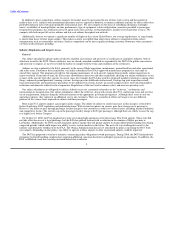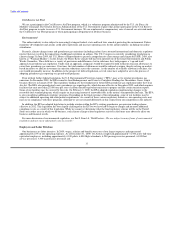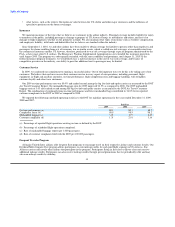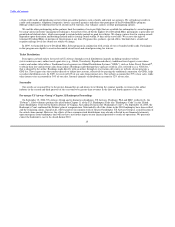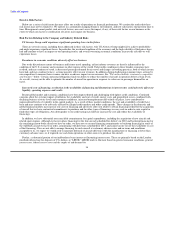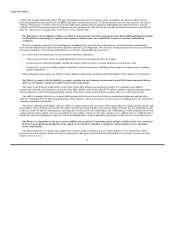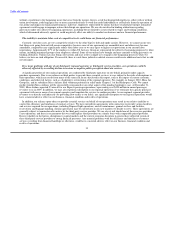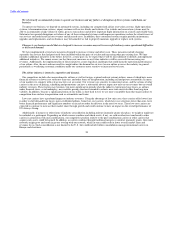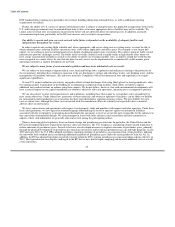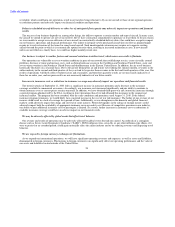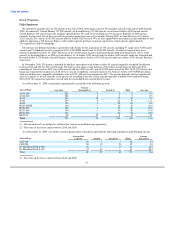US Airways 2009 Annual Report Download - page 21
Download and view the complete annual report
Please find page 21 of the 2009 US Airways annual report below. You can navigate through the pages in the report by either clicking on the pages listed below, or by using the keyword search tool below to find specific information within the annual report.
Table of Contents
without a resolution to the bargaining issues that arose from the merger, there is a risk that disgruntled employees, either with or without
union involvement, could engage in one or more concerted refusals to work that could individually or collectively harm the operation of
our airline and impair our financial performance. Likewise, employees represented by unions that have reached post-merger integrated
agreements could engage in improper actions that disrupt our operations. We are also involved in binding arbitrations regarding
grievances under our collective bargaining agreements, including but not limited to issues related to wages and working conditions,
which if determined adversely against us could negatively affect our ability to conduct our business and our financial performance.
The inability to maintain labor costs at competitive levels could harm our financial performance.
Currently, our labor costs are very competitive relative to the other big five hub-and-spoke carriers. However, we cannot assure you
that labor costs going forward will remain competitive because some of our agreements are amendable now and others may become
amendable, competitors may significantly reduce their labor costs or we may agree to higher-cost provisions in our current labor
negotiations. Approximately 87% of the employees within US Airways Group are represented for collective bargaining purposes by labor
unions, including unionized groups of our employees abroad. Some of our unions have brought and may continue to bring grievances to
binding arbitration. Unions may also bring court actions and may seek to compel us to engage in the bargaining processes where we
believe we have no such obligation. If successful, there is a risk these judicial or arbitral avenues could create additional costs that we did
not anticipate.
If we incur problems with any of our third-party regional operators or third-party service providers, our operations could be
adversely affected by a resulting decline in revenue or negative public perception about our services.
A significant portion of our regional operations are conducted by third-party operators on our behalf, primarily under capacity
purchase agreements. Due to our reliance on third parties to provide these essential services, we are subject to the risks of disruptions to
their operations, which may result from many of the same risk factors disclosed in this report, such as the impact of current economic
conditions, and other risk factors, such as a bankruptcy restructuring of the regional operators. For example, in January 2010, Mesa Air
Group Inc. and its subsidiary Mesa Airlines filed voluntary petitions for relief under Chapter 11 of the Bankruptcy Code. We cannot
predict whether Mesa Airlines will be successfully reorganized or any other aspect of the pending bankruptcy case. At December 31,
2009, Mesa Airlines operated 53 aircraft for our Express passenger operations, representing over $450 million in annual passenger
revenues to us in 2009. In addition, we may also experience disruption to our regional operations if we terminate the capacity purchase
agreement with one or more of our current operators and transition the services to another provider. As our regional segment provides
revenues to us directly and indirectly (by providing flow traffic to our hubs), any significant disruption to our regional operations would
have a material adverse effect on our business, financial condition and results of operations.
In addition, our reliance upon others to provide essential services on behalf of our operations may result in our relative inability to
control the efficiency and timeliness of contract services. We have entered into agreements with contractors to provide various facilities
and services required for our operations, including Express flight operations, aircraft maintenance, ground services and facilities,
reservations and baggage handling. Similar agreements may be entered into in any new markets we decide to serve. These agreements are
generally subject to termination after notice by the third-party service provider. We are also at risk should one of these service providers
cease operations, and there is no guarantee that we could replace these providers on a timely basis with comparably priced providers.
Recent volatility in fuel prices, disruptions to capital markets and the current economic downturn in general have subjected certain of
these third-party service providers to strong financial pressures. Any material problems with the efficiency and timeliness of contract
services, resulting from financial hardships or otherwise, could have a material adverse effect on our business, financial condition and
results of operations.
19


